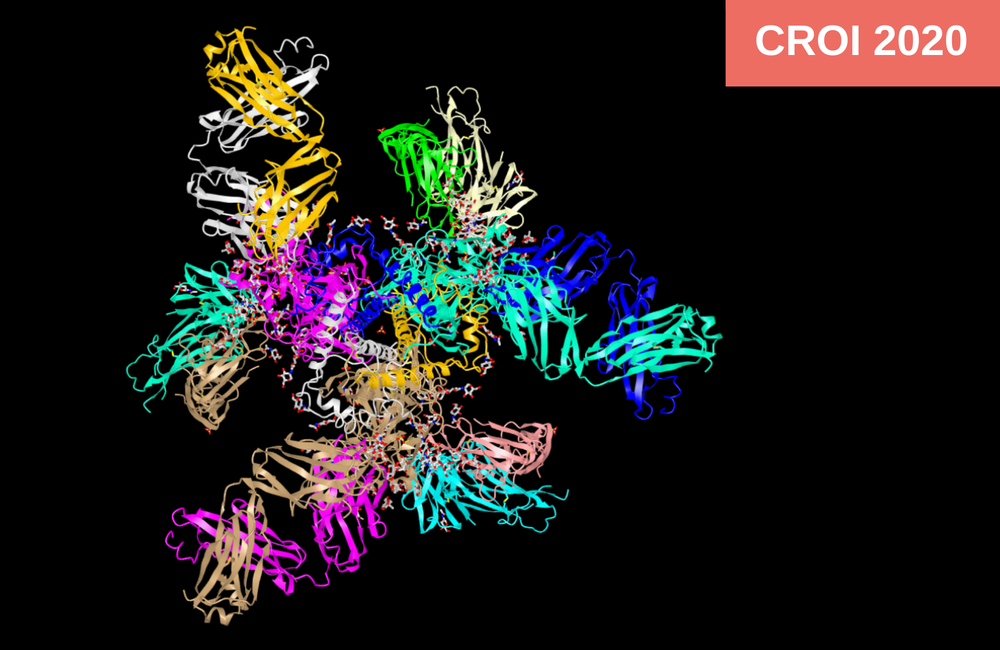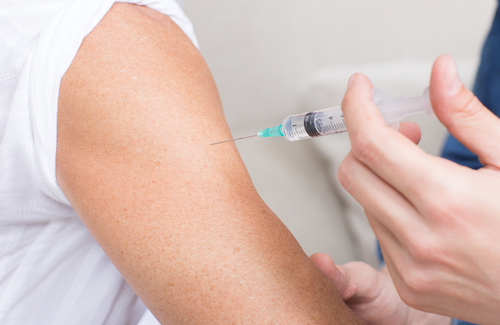
The Conference on Retroviruses and Opportunistic Infections (CROI 2020) heard this week how scientists had, for the first time, devised a vaccine that induced human cells to generate broadly neutralising antibodies to HIV.
The presentation, by Dr Joseph Casazza, of the US National Institutes of Health, may highlight an important step forwards towards a vaccine that could work both for HIV prevention and HIV treatment.
About HIV, antibodies and bNAbs
Most vaccines work by inducing the B-cells of the immune system to make antibodies against the infection that the vaccine mimics. Antibodies are an extraordinarily variable set of soluble protein molecules that attack pathogens and either destroy them directly, or ‘tag’ infected cells so they can be destroyed by other parts of the immune system.
So far, however, the results for HIV vaccines have been disappointing. Although we have learned through trials that some HIV vaccines can indeed induce anti-HIV antibody responses, they have proved to be either ineffective (as in the recent HVTN 702 study, also discussed at CROI) or only marginally effective (as in the RV 144 vaccine study).
It is not a surprise that it is hard to generate effective antibody responses to HIV. Standard HIV tests detect antibodies against HIV and not the virus itself or its components. Clearly our antibody response is ineffective, or HIV infection would not be lifelong.
Exactly why anti-HIV antibodies don’t work is a subject still under investigation; if we had a complete answer, we’d likely have a vaccine. However there appear to be three main, and related, reasons.
One is the tremendous genetic variability of HIV: most naturally-generated antibodies work only against the specific virus that induces them, and not others. Secondly, there is so-called ‘glycan shielding’; HIV shields its envelope protein, which forms the ‘knobs’ on its surface that are both its key to enter cells and the main thing antibodies latch on to, with a blanket of sticky sugar molecules that resist penetration.
Thirdly, and most importantly, there is immune escape. Because HIV is so variable and mutates as it reproduces, it can easily develop ‘resistance’ to antibodies, as it does to medicines. Chronic HIV infection involves an 'arms race' between the immune system and a virus that is always one step ahead of it.
Broadly neutralising antibodies (bNAbs) overcome the first two barriers, and could overcome the third if they were generated in enough time. 'Broadly' indicates that they are active against a wide variety of different viral strains. They also have unusual extensions to normal antibody proteins that enable them to penetrate the glycan shield. This means they can react to and attach to the most 'conserved' parts of HIV – the bits HIV needs to shield because it cannot afford to change them.
However, bNAbs only ever develop in a minority of people with HIV and even then only after years of infection. By this time it is too late: the virus has usually mutated and, in addition, long-term HIV infection can exhaust the overall functioning of the immune system.
If, however, we could confront HIV with bNAbs, either as it tried to get into the body or during acute infection before it has 'seen' them already, they could form the basis of powerful vaccines and treatments, and even form part of what’s needed for a cure.
Infusing bNAbs – using them like a long-lasting drug – is already underway in trials such as the Antibody Mediated Protection (AMP) study, which reports its first findings later this year.
A bNAb-generating vaccine
What would be much better, however, would be a vaccine that could induce the body to produce its own bNAbs. Last year, we reported on a study that produced this result in monkeys. The successor to that study is currently underway in humans, using a stabilised version of the HIV envelope protein that lasts long enough in the blood to stimulate bNAb production.
This year, CROI heard about a different technology: a study by the US National Institutes of Health that used a viral vector vaccine. This consisted of the shell of the adenovirus AAV-8, from a viral family that most often produces common colds, with its viral genes replaced by lengths of DNA that code for the production of VRC07, a bNAb that has been widely used in studies to develop HIV treatment, PrEP and a cure.
Dr Casazza told the conference that VRC07 was chosen because an assay that easily detects its presence in the body is available, and because it does not stimulate the production of 'anti-antibodies' – opposing antibodies that treat VRC07 as a foreign pathogen itself, and neutralise it.
The vector DNA also included genes that facilitate the viral infection of cells – taken from species as different as other viruses, humans, chickens and groundhogs.
In a phase I safety study, this vaccine was given to eight HIV-positive volunteers. They were between 30 and 60 years old (average age 52); six were men and two were women; five were African-American and three white. All had a viral load below 25, and their average CD4 count was 528.
The vaccine was given in three different schedules. The first three volunteers were given one vaccination (it actually consisted of two intramuscular shots) containing a dose of 50 billion vector genomes per kilogram of body weight. The first volunteer was given this dose in January 2018. Two more volunteers were given one vaccination containing ten times as many vectors per kilo (500 billion); the first started in April 2018.
The last three volunteers were given a cumulative dose of five times that dose (2.5 trillion vectors/kg); the first started in March 2019. Because this much cannot be given in one shot, the dosing schedule consisted of eight or nine separate shots, alternating between shoulder and thigh muscles to minimise reactions. The three volunteers from this arm did complain of mild pain and tenderness at the injection site; one volunteer in the second arm developed mild-systemic muscle aches, a common reaction to vaccines.
The amount of vector vaccine circulating in the blood fell rapidly after the last inoculation, with the exception of one volunteer who received the multi-shot regimen. All volunteers produced antibodies to the viral capsid (shell), but this did not appear to prevent the generation of VRC07 antibodies.
All volunteers given the vaccine produced VCRC07 antibodies, to a greater or lesser degree. This didn’t happen immediately. There was an early peak in antibody production about six weeks after the first inoculation. In three volunteers (one in each arm) that was as far as it went: bNAb production tailed off completely in two volunteers and was maintained at a very low level in the third. It turned out later that these three volunteers had produced anti-antibodies to VRC07.
In the other five participants, however, antibody production started increasing again about 14 weeks after inoculation and reached a second peak, with bNAb levels about the same or greater than at the first peak, at week 20.
In the multi-shot arm, bNAb levels were about twice what they were at the first peak. Although levels in one volunteer started to decline again at week 22, in the other volunteer they stayed at high levels and have so far been maintained to 48 weeks, or nearly a year, after the first inoculation.
As the volunteers will be followed for five years, it will be possible to see if there are later increases in antibody production. However, as this is a safety study we do not know yet whether the VRC07 levels produced are sufficient for an anti-viral effect.
Engineering HIV proteins to enhance bNAb responses
This study offers the first proof that a vaccine can induce the production of bNAbs in people given it. It will not be the last. As mentioned above, the successor to the Scripps Institute monkey study we reported last year is underway. Instead of using a vector, this uses a special version of the HIV envelope protein itself, and could potentially induce the body to produce a variety of bNAbs, not just one.
Dr Shane Crotty of the La Jolla Institute for Allergy and Immunology, which shares scientists with the Scripps Institute, said that vector vaccines might not be necessary to stimulate antibody production, as even though the production of bNAbs to HIV occurred only late and in a minority of people with the virus, it had been discovered that most people had B-cells in their immune system that were capable of producing bNAbs.
However, these cells were rare: only one in about 300,000 B-cells had this capability. The cells were discovered in a “phase zero” study that used an artificial immune probe called eOD-GT8 to lock on to them. This molecule is itself currently in a clinical trial as a vaccine, and results are pending.
Previous studies dating back to 1999 and using HIV proteins themselves – the most direct and potentially scalable approach – have been disappointing (see “The Search for a Vaccine” in this report on the HVTN 702 trial.)
This is partly because if the HIV envelope protein is injected in a soluble form as a vaccine, instead of as part of an invading virus, it soon degrades. The Scripps monkey and current human studies use a stabilised version of the HIV envelope trimer (triple-component) molecule called BG505 SOSIP that retains its identity long enough to stimulate a better immune response.
However, the main problem is a phenomenon called immunodominance. What this means is that the main antibody response the B-cells create is mis-directed: they mainly produce non-neutralising antibodies to irrelevant parts of the viral protein, not to the vital 'conserved' regions.
This is partly because the epitopes, the conserved parts of the envelope protein that the bNAb-producing cells, are less ‘exciting’ to the B-cells and get less attention, and partly because the B-cells that produce bNAbs aren’t as productive as the other B-cells. Producing bNAbs takes more energy – and so takes more time too, such that what they do produce is soon overtaken by the general antibody response.
However, the Scripps scientists have found a way round this by producing a slow-release system. This is a so-called ‘osmotic pump’, which contains the same dose of vaccine in an implant the size of a vitamin capsule. It slowly releases the vaccine over a period of weeks.
This resulted, when tested in monkeys, in tenfold higher levels of antibodies in general, and at least a thousand times as many bNAbs. The peak of release was also delayed to about 12 weeks after inoculation rather than eight to ten. In three cases the monkeys did not even start to produce bNAbs till weeks 14-16 after inoculation.
The other problem with immunodominance is that it restricts the bNAb response to a very narrow genetic range before cutting it off altogether, which is no match for HIV’s genetic diversity, and may be an Achilles heel in approaches that produce single bNAbs. However, using the osmotic pump resulted in a much broader response that – in the monkeys at least – enabled them to fight off a number of challenges with a pathogenic SIV.
Casazza JP et al. Durable HIV-1 antibody production in humans after AAV8-mediated gene transfer. Conference on Retroviruses and Opportunistic Infections, abstract 41LB, March 2020.
View the abstract on the conference website.
Watch the webcast on the conference website.
Crotty S. Engineering vaccine immunity. Conference on Retroviruses and Opportunistic Infections, plenary presentation 112, March 2020.

